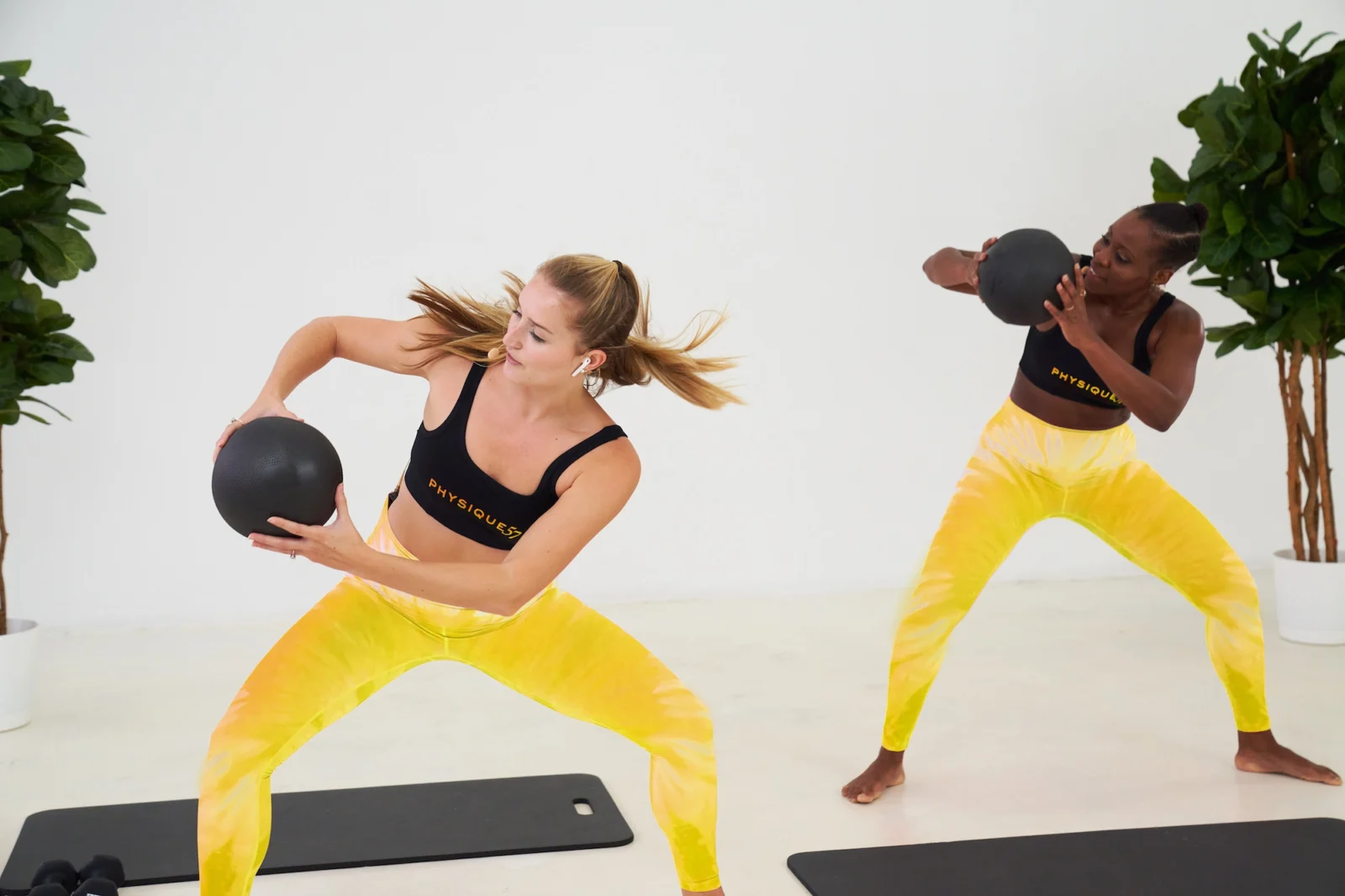How Physique 57 Built a Barre Empire, Then Took It Online

Physique 57’s pandemic pivot was a continuation of how Jennifer Maanavi and Tanya Becker have been doing business since 2005
If you want to survive in the notoriously fickle boutique fitness industry, adaptability is key. For Physique 57, the ability to quickly change course and seize new business opportunities has been critical to the brand’s success over nearly two decades.
Jennifer Maanavi and Tanya Becker created the highly popular Barre concept in 2005, and the co-founders have implemented some radical changes to their business model since then. That includes branching out into DVD sales, being an early adopter of digital fitness content and most radically of all, closing down nearly all of their studios and terminating the majority of their staff at the start of the pandemic.
“I fired 95 people the first day of the pandemic and permanently closed all of our studios, except for one,” Maanavi tells Athletech News. “I knew it was going to go on forever, so I moved fast. I was out of any (lease) I needed to be out of within four or five months.”
Maanavi’s decision may have seemed hasty at the time, but it proved prophetic, as the Northeast, where the bulk of Physique 57’s studios were located, became mired in lockdowns that wreaked havoc on the boutique fitness industry.
Physique 57’s quick thinking at the outset of the pandemic allowed the brand to pour all of its energy and resources into producing more online content. Due to COVID lockdowns in indoor spaces, the Physique 57 team had to get creative, filming Barre workouts at outdoor locations like New York City parks as well as some more unlikely locales.
“One of our best-performing video series at the time featured one of my top instructors at her boyfriend’s parents’ house by the pool,” Maanavi recalls. “There were deer in the background, but we just had to do it.”
The strategy paid off. Before the pandemic, around 10 percent of Physique 57’s revenue came from its On-Demand service, which at that time cost $24 a month. Today, digital accounts for half of the Barre brand’s total revenue, even as boutique fitness consumers flock back to in-person classes in large numbers post-pandemic. Physique 57 On-Demand currently features over 450 Barre workouts as well as classes that are live-streamed. Separately from its On-Demand service, Physique 57 also broadcasts Barre classes live from its SoHo studio over Zoom, giving people across the country the opportunity to get a taste of the in-class experience from the comfort of home.

Masters of the Pivot
In many ways, Physique 57’s pandemic pivot was a continuation of how the brand has been doing business since its inception in 2005. Around that time, Maanavi decided to leave her job in corporate finance and finally take the leap into entrepreneurship, something she became fascinated with as an MBA student five years earlier but didn’t jump into just yet since the timing wasn’t right.
That changed when the Lotte Berk Method, a popular Barre studio in NYC’s Upper East Side, closed its doors after several decades in business. Maanavi, a longtime Barre fanatic and Lotte Berk devotee, partnered with Becker, the studio’s top instructor, to create a new Barre concept that was similar to the one she loved but different in a few important ways.

Maanavi and Becker wanted to create a Barre concept that could serve as the only workout people needed in their fitness regime. To accomplish that, they increased the cardio, added some interval training aspects and made the classes faster with more music.
“A differentiating factor is that our classes are more challenging, more dynamic and usually faster-paced,” Maanavi says of what separates Physique 57 from other Barre classes. “One of the reasons is because we use the Barre in so many different ways.”
With that bit of programming alchemy, Physique 57 was born, its name being a nod to the brand’s first location on 57th Street in Manhattan as well as its signature 57-minute workouts.
The concept quickly found success in the Big Apple and beyond, attracting attention from celebrities in the mid to late 2000s including Christy Turlington, Kelly Ripa and Sarah Jessica Parker.
“We were lucky to have been in some reputable publications early, including W magazine, Vogue and Shape,” Maanavi says, noting that those placements, along with its unique take on Barre, helped Physique 57 gain traction with celebrities.
To capitalize on the brand’s sudden burst of national notoriety, Maanavi and Becker decided to sell DVDs of Physique 57 workouts to consumers across the country.
“Instead of investing money in another New York City studio, which has a local clientele, I wanted to leverage the fact that we have this national brand,” Maanavi explains. “I thought if we made DVDs and we sold them around the country, that would be a way to monetize the celebrity buzz around Physique 57. Within 30 days, we sold DVDs in all 50 states.”
DVDs quickly became a huge part of Physique 57’s burgeoning business, but the boom was short-lived as digital technology quickly made physical discs all but obsolete.
“It was a seven-figure business for us that just evaporated as soon as the Internet became a thing and you could digitize content,” Maanavi says.
Physique 57 quickly pivoted, making its workouts available online in 2011, a time when the concept of streaming was still alien to most boutique fitness brands.
“With the advice of a 24-year-old in the business, we quickly digitized the content. I didn’t even know what she was talking about when she brought it up to me,” Maanavi jokes.
Still, digital content accounted for only a small fraction of Physique 57’s total revenue for the rest of the 2010s; Maanavi and her team continued to focus primarily on physical expansion both domestically and internationally until the pandemic hit. Physique 57 even began franchising in 2019, selling licenses right up until March 2020 as part of a nationwide expansion plan that was definitively halted due to COVID.
But those early overtures into online content proved critical for Physique 57 once digital fitness became the new normal.
“When COVID came and on-demand fitness became a craze, we were very much there already,” Maanavi says.

Blending Brick-and-Mortar With Digital
Post-pandemic, Physique 57 is very much a digital media company in addition to being a brick-and-mortar boutique fitness brand.
While Physique 57 has opened some new studios, primarily in New York and its surrounding states, to help make up for the ones it closed due to the pandemic, the brand isn’t overly focused on physical expansion.
“There’s a lot more opportunity on the digital side,” Maanavi explains. “It’s slowed down a bit from 2020 when the whole world was locked down, but there’s no indication that it’s growing at a slower rate than in 2018 or 2019, and it was growing back then. We get new people signing up all the time. We just increased prices (from $24 to $29 per month).”
Maanavi isn’t yet sure if digital will become a bigger slice of Physique 57’s revenue pie than its current 50% piece, but she believes the brand has a good strategy to remain adaptable: focus on digital while strategically placing studios in the Northeast and key overseas markets. Right now, the brand has eight domestic studios open in New York, New Jersey, Pennsylvania and Indiana (the last one being the result of a franchise agreement signed before the pandemic). Internationally, Physique 57 has a physical presence in Dubai, India and Thailand.
Earlier this month, Physique 57 opened its latest studio, on 14 E. 60th Street in Manhattan.
“I think having a tight regional footprint in the tri-state area and having digital, plus the international component, is a good bet,” Maanavi says.
The Future of Barre
As the boutique fitness landscape continues to evolve, Physique 57’s relatively small size in terms of employees and physical locations could give it a competitive advantage over bigger Barre brands. Maanavi notes that the Barre industry, at least in the U.S., is mostly dominated by a handful of big-name franchise companies.
“They’re good franchises, there’s nothing wrong with them at all, but there aren’t many Barre brands like us that are independently owned and female-led,” Maanavi says. “We don’t have outside investment, so we can be nimble. We can decide to open a studio based on whatever criteria we have and we can iterate consistently.”

Moving forward, Maanavi hopes to see more innovation in the Barre industry as a whole, which she notes has a reputation for lagging behind some other boutique fitness modalities despite its profound health benefits for women of all ages.
“I’ve always believed Barre is the healthiest thing for women to do well into their 50s and 60s,” Maanavi says, adding that she’s been using Physique 57 as her only workout for years now, and to great effect.
“I don’t run, but my resting heart rate is 55,” she notes. “When I go for a physical, the doctor asks, ‘Do you run marathons?’”



